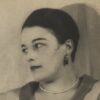“It takes about four weeks, but it’s like magic every time you see it!” one of the workers enthuses.
And it was under one of these top-floor upheavals that I headed over to its basement warehouse to check out Holly Davey’s The Unforgetting.
It’s a simple idea. A wooden structure stands in the entrance with a ribbon deftly placed as a shadow beneath it. Along the corner of the wall is a black shelf, like one you’d find in a museum’s archives, showing clay sculpture after clay sculpture, all completely identical. Prompt desks lay across the wall with paper laid across them. And a woman’s voice lists out the names of every female artist who has ever had their artwork exhibited in the Fruitmarket alongside a metronome, leaving just the ticking metronome for every male or non-binary artist.
READ MORE: An immersive exhibition by award-winning Scottish-Ghanaian artist set to open
And there’s a lot of ticking. More than 800, invigilator Jamal predicts, compared to just 354 women.
It fills the huge basement fantastically. Though full of artefacts, the pieces are spread out, leaving the names of the women and the droning metronome all you can focus on.
Though the speakers sit behind the models, you can’t seem to get away from it – it echoes throughout the whole gallery and even if you decide not to head towards the models for a closer look or take a glance at the script, you can’t escape it. The piece forbids you from ignoring, forgetting, the women who contributed but often went unnoticed by history.
So what is this all about? An essay by Fruitmarket Fiona Bradley included in a newspaper supplement Davey added to the piece lays out the facts.
Because Davey isn’t just an artist. Through this piece, she becomes a historian, a researcher, proudly showing you the culmination of her work as well as a detective, scouring the archives of not just the Fruitmarket but women’s art in general and presenting her findings in the form of contemporary art. She shines light on the importance of history and documents, reconnects present with history – and what other way of doing this than having Jill Bruce, the first woman ever to display art at Fruitmarket, to give the voiceover.
Bradley describes this as linking the past with the present, and I couldn’t agree more. Davey’s work is an exploration of the archives and sheds a vital light on the importance of archiving work. As I head over to the prompt desks, I’m drawn to repeated names, famous artists like Yoko Ono and Claude Cahun, and artists I remember being drawn to on previous visits to the gallery. None are given more weight than others, they’re all recalled in the same monotonous tone Bruce gives us.

What about the models? They’re recreations of a model, Little Bather II by Edinburgh College of Art teacher Ann Henderson. Though not one of the names, her impact on the art world was second-to-none, and Davey brings her to the forefront.
Her sculpture, though not featuring in the piece, is recreated in clay and outlined in a shadow on the floor as well as etched onto the script laid out on prompt desks which mimic the idea of study desks in a library. You’re taken inside the performance, as Bradley says in her essay – visitors are the audience, Davey the director, Bruce the performer and the women artists the stars.
And Henderson the unsung hero. As Bradley says, her work casts a literal shadow over the entire piece.
Leaving the gallery, I come to the newspaper. It depicts photographs and Davey’s recreations of pieces by these artists in soft negatives alongside what almost appears as an ode to women artists. She addresses the archive itself and explains why she felt so drawn to Henderson. It’s emotive, and Bradley’s words ring in my ears of it being a remembrance over a commemoration, as clearly so much of Davey was put into what has become a strikingly unique piece of contemporary art.
Invigilator Andrew tells me that it took only a few hours for a man to go up to him and complain about the piece. About how it was making something political and that it didn’t matter. But that’s exactly Davey’s point. You create pieces like this often because of the backlash they create. Until we live in a world where something like this is unnecessary – when the number of men in an art gallery don’t more than double the number of women – the piece will stay relevant.
And those women will stay unforgotten.
The Unforgetting is on at Edinburgh’s Fruitmarket art gallery until Sunday, November 17









